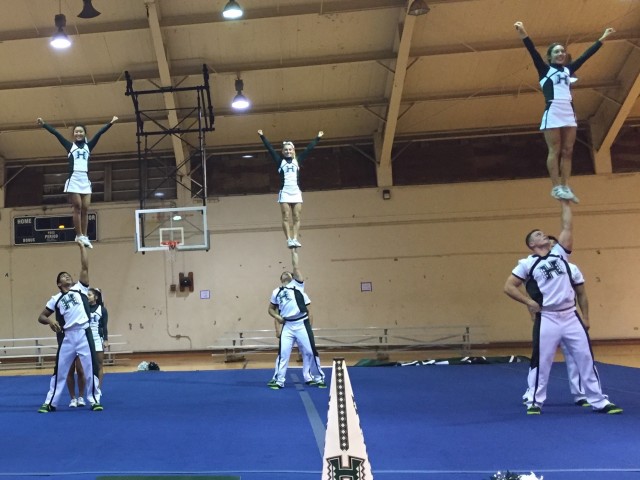Season of Cheer

Playing a supportive role at UH events the rest of the year, the Rainbow cheerleading team makes its return to the Universal Cheerleaders Association Collegiate National Championships this weekend thanks in part to the backing of fans.
After a four-year absence, UH is among 22 teams in Saturday’s Division IA semifinals at the ESPN Wide World of Sports Complex in Orlando, Fla. with the finals set for Sunday. The competition will be streamed online.
“I think this program thrives on competing because we’re able to pull in some of the top people in the country,” said UH coach Mike Baker, now in his 10th year.
“We’ve built a reputation up and it’s been hard without nationals. … When we have some world-class athletes, we have to compete.”
UH placed in the top 10 15 times over a 20-year stretch, including a seventh-place showing in 2012. But a rule change put the competition out of reach for the next four years.
Up to 2012, teams could submit a video demonstrating the team’s skills to earn a paid bid covering travel expenses and registration fees. In 2013, the UCA began awarding the bids based on results, with the top five teams having their return trip paid for the following year.
Baker said the stakes add to the competition, but the distance “makes it hard for a school like the University of Hawaii to get over there.”
“We just need to get over there so we can earn it,” Baker said. “It’s been a journey getting back for sure.”
Baker said the trip costs close to $30,000 and is separate from the funds the program receives from the school.
“The (athletic) department does a lot for the cheerleaders,” Baker said. “We try to keep competition separate from the department, because we feel like our main purpose is the games and the things we do on campus. For a competition like that, we work outside the department. We don’t want that to be a burden.”
The team built its account through performances and clinics and received help from fans and alumni to hit its fundraising goal in time for this year’s competition.
“We’ve been fundraising since I first got here,” said senior Lindsey Wabs, a Maryknoll graduate preparing for her first and last competition. “It’s taken us a long time. … There were a lot of generous people that helped us.”
With nationals back on the calendar, the team began working on their routine incorporating an array of acrobatic stunts and tumbling when they assembled in August and their in-season appearances at UH events doubled as preparation for competition.
“One of the best things we did to prepare was take the stunts we’re using in this routine and applied it onto the football field for timeouts,” senior Jerick Ibias said. “We were in front of such a huge crowd, especially with this year’s football program. We were able to get a good audience, feel the pressure of making sure we hit our stuff and I think that’s helping us a lot.”
While the team has been preparing for the nationals, Baker said the program’s first priority remains “to take care of the university with the games and support our athletes here and be ambassadors for the university.”
“For them being able to compete is neat because this is one way we get to go up against our peers and show what Hawaii is all about and what the University of Hawaii has to offer,” he said.
Although they play a supportive role in the game-day atmosphere, Ibias and Wabs said the cheerleaders’ efforts are also recognized by the coaches and athletes on the field or court as well.
“We’re really connected with the coaches. … They’re super appreciative and we’re appreciative of them,” Ibias said.
The team showed off its routines at Klum Gym on Wednesday with volleyball standout Nikki Taylor and former basketball player Sai Tummala among those attending the send off.
“It’s not easy doing what they do and how much they practice and I know they work really hard,” Tummala said. “It means a lot having that consistent support.”
COMMENTS